Papers by Virginie Sinet-Mathiot
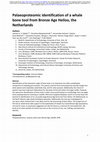
bioRxiv (Cold Spring Harbor Laboratory), Apr 19, 2024
Identification of the taxonomic origin of bone tools is an important, but often complicated, comp... more Identification of the taxonomic origin of bone tools is an important, but often complicated, component of studying past societies. The species used for bone tool production provide insight into what species were exploited, potentially how, and for what purpose. Additionally, the choice of species may have important implications for the place of the tool within the larger toolkit. However, the taxonomic identification of bone tools is often unsuccessful based on morphology. Here we apply three palaeoproteomic techniques, ZooMS, SPIN and a targeted database search to narrow down the taxonomic identification of an unusually large Bronze Age bone tool from Heiloo, the Netherlands, to the North Atlantic right whale (Eubalaena glacialis). Additionally, the tool was investigated for use-wear, which showed that it was likely used for the processing of plant fibres. The assignment of the tool as whale bone adds support to the exploitation of whales by coastal Bronze Age populations, not just for meat, as previously suggested, but also for bone as a resource for tool production. We know of no other parallel of a bone tool such as this in terms of size, use, hafting, and taxonomic identity.
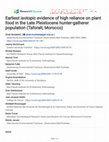
The transition from hunting-gathering to agriculture stands as one of the most significant dietar... more The transition from hunting-gathering to agriculture stands as one of the most significant dietary revolutions in human history. Yet, due to a scarcity of well-preserved human remains from Pleistocene sites, little is known about the dietary practices of pre-agricultural human groups. Here, we present the first isotopic evidence of pronounced plant reliance among Late Pleistocene hunter-gatherers from North Africa, predating the advent of agriculture by several millennia. Employing a comprehensive multi-isotope approach, we conducted zinc (δ66Zn) and strontium (87Sr/86Sr) analysis on dental enamel, carbon (δ13C), and nitrogen (δ15N) isotope analysis on dentin and bone collagen, alongside single amino acid analysis on humans and fauna from Taforalt (Morocco). Our results unequivocally demonstrate a substantial plant-based component in the diets of these hunter-gatherers. This distinct dietary pattern challenges the prevailing notion of high reliance on animal proteins among pre-agric...

Archaeological and Anthropological Sciences
Understanding Palaeolithic hominin subsistence strategies requires the comprehensive taxonomic id... more Understanding Palaeolithic hominin subsistence strategies requires the comprehensive taxonomic identification of faunal remains. The high fragmentation of Late Pleistocene faunal assemblages often prevents proper taxonomic identification based on bone morphology. It has been assumed that the morphologically unidentifiable component of the faunal assemblage would reflect the taxonomic abundances of the morphologically identified portion. In this study, we analyse three faunal datasets covering the Middle to Upper Palaeolithic transition (MUPT) at Bacho Kiro Cave (Bulgaria) and Les Cottés and La Ferrassie (France) with the application of collagen type I peptide mass fingerprinting (ZooMS). Our results emphasise that the fragmented component of Palaeolithic bone assemblages can differ significantly from the morphologically identifiable component. We obtain contrasting identification rates between taxa resulting in an overrepresentation of morphologically identified reindeer (Rangifer t...
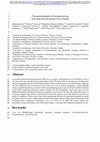
Lincombian-Ranisian-Jerzmanowician (LRJ) sites are sparse, and Koziarnia Cave in Poland is one of... more Lincombian-Ranisian-Jerzmanowician (LRJ) sites are sparse, and Koziarnia Cave in Poland is one of only few such sites situated at the eastern fringe of LRJ. The aim of the recent study was to obtain new chronostratigraphic data for the LRJ industries due to their extreme scarcity in Central Europe. Although the new fieldworks did not bring newfossil directeursuch as bifacial leafpoints, a detail debitage analysis enabled identifying a presence of the ventral thinning chips in layer D, which could be identified as the LRJ assemblage-containing stratum. Besides the LRJ assemblage, strata with traces of Late Middle Palaeolithic and Early Gravettian occupation were found at the site. The radiocarbon dates of Koziarnia samples show that the archaeological settlement represent one of the oldest Gravettian stays north to Carpathians. What is more, these dates demonstrate that the cave had been alternately occupied by humans and cave bears. Additionally the radiocarbon dates indicate rather...

Journal of Archaeological Science: Reports, 2021
Abstract Marine Isotope Stage 3 is considered a period with several climate oscillations that dro... more Abstract Marine Isotope Stage 3 is considered a period with several climate oscillations that drove the environments to rapid changes. To understand how these stadial-interstadial cycles affected southern Poland, we combined the results of eight proxies analysed in the samples from the old excavations and a new 2017 trench of Koziarnia Cave (Ojcow National Park, Krakow-Czestochowa Upland, Poland) in layers related to Middle Palaeolithic, Jerzmanowician, and Early Gravettian. Among the studied proxies were charcoals, pollen record, remains of malacofauna, and vertebrates (including rodents, birds and large mammals, and ZooMS analysis of fragmented bones). Moreover, sediment samples have been analysed for lipid composition (by Gas Chromatography-Mass Spectrometry, GC–MS). Despite several taphonomic issues, it was possible to recognise two oscillations. The first one, reflected in pollen record and lipid analysis, took place during Dansgaard-Oeschger (DO) 14 to 8 and included Heinrich Stadial (HS) 4. The second one, recorded by rodents and bird proxies, was related to DO 8/7 to DO 6 and included HS 3. Charcoal and large mammal proxies provided the broad context of our study. The Jerzmanowician occupation was connected with a relatively cold episode in a landscape characterized mainly by grassland and periglacial environments, while the Late Middle Palaeolithic and Early Gravettian groups settled the cave during milder climatic conditions, where environments were open with sparse boreal woodlands. Such trends provide additional arguments in a broad discussion on Middle-Upper Palaeolithic transition in Central Europe.
HAL (Le Centre pour la Communication Scientifique Directe), 2023

Journal of Quaternary Science
Pleistocene faunal assemblages are often highly fragmented, hindering taxonomic identifications a... more Pleistocene faunal assemblages are often highly fragmented, hindering taxonomic identifications and interpretive potentials. In this paper, we apply four different methodologies to morphologically unidentifiable bone fragments from the Neanderthal open-air site of Salzgitter-Lebenstedt (Germany). First, we recorded zooarchaeological attributes for all 1362 unidentifiable bones recovered in 1977. Second, we applied zooarchaeology by mass spectrometry (ZooMS) to 761 fragments, and calculated glutamine deamidation values. Third, we assessed the collagen preservation of 30 fragments by near-infrared spectroscopy (NIR) and, finally, we pretreated 10 bones with high predicted collagen values for radiocarbon dating. All returned dates at, or beyond, the limit of radiocarbon dating, indicating an age of older than 51 000 years ago. The ZooMS faunal spectrum confirms a cold environment, dominated by reindeer, alongside mammoth, horse and bison. The low occurrence of carnivore modifications (1%) contrasts with an abundance of human modifications (23%). Cut marks and marrow fractures were observed across reindeer, horse and bison. The mammoth remains are less well preserved and show a lower degree of human modifications, indicating, perhaps, a different taphonomic history. Overall, this study illustrates the importance of retaining, studying and incorporating the unidentifiable bone fraction to optimize interpretations of site formation and subsistence behaviour at Palaeolithic sites.
CERN European Organization for Nuclear Research - Zenodo, Oct 19, 2022
Le Centre pour la Communication Scientifique Directe - HAL - Université Jean Moulin Lyon 3, Sep 18, 2014
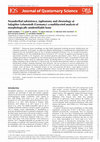
Journal of Quaternary Science, 2023
Pleistocene faunal assemblages are often highly fragmented, hindering taxonomic identifications a... more Pleistocene faunal assemblages are often highly fragmented, hindering taxonomic identifications and interpretive potentials. In this paper, we apply four different methodologies to morphologically unidentifiable bone fragments from the Neanderthal open-air site of Salzgitter-Lebenstedt (Germany). First, we recorded zooarchaeological attributes for all 1362 unidentifiable bones recovered in 1977. Second, we applied zooarchaeology by mass spectrometry (ZooMS) to 761 fragments, and calculated glutamine deamidation values. Third, we assessed the collagen preservation of 30 fragments by near-infrared spectroscopy (NIR) and, finally, we pretreated 10 bones with high predicted collagen values for radiocarbon dating. All returned dates at, or beyond, the limit of radiocarbon dating, indicating an age of older than 51 000 years ago. The ZooMS faunal spectrum confirms a cold environment, dominated by reindeer, alongside mammoth, horse and bison. The low occurrence of carnivore modifications (1%) contrasts with an abundance of human modifications (23%). Cut marks and marrow fractures were observed across reindeer, horse and bison. The mammoth remains are less well preserved and show a lower degree of human modifications, indicating, perhaps, a different taphonomic history. Overall, this study illustrates the importance of retaining, studying and incorporating the unidentifiable bone fraction to optimize interpretations of site formation and subsistence behaviour at Palaeolithic sites.
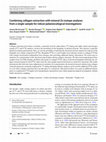
Archaeological and Anthropological Sciences
Collagen extraction from bones or dentine, commonly used for radiocarbon (14C) dating and stable ... more Collagen extraction from bones or dentine, commonly used for radiocarbon (14C) dating and stable carbon and nitrogen isotope (δ13C and δ15N) analyses, involves the dissolution of the bioapatite of skeletal elements. This fraction is typically disposed of during pretreatment. Here, we test the possibility of utilising this dissolved mineral solution for analysis of the bioapatite zinc isotope composition (δ66Zn). Bioapatite δ66Zn is a novel trophic level indicator similar to collagen δ15N but with isotopic fractionation independent from nitrogen, thus providing additional dietary information. We tested ways to minimise Zn contamination of the dissolved mineral phase during collagen extraction. We then used archaeological bone samples from Ain Difla (Jordan) and Ranis (Germany) to compare δ66Zn values of dissolved bioapatite following our collagen extraction protocol with δ66Zn values from the same sample material dissolved in a metal-free cleanroom. Our results demonstrate that with ...

Journal of Human Evolution
The expansion of Homo sapiens and our interaction with local environments, including the replacem... more The expansion of Homo sapiens and our interaction with local environments, including the replacement or absorption of local populations, is a key component in understanding the evolution of our species. Of special interest are artifacts made from hard animal tissues from layers at Bacho Kiro Cave (Bulgaria) that have been attributed to the Initial Upper Paleolithic. The Initial Upper Paleolithic is characterized by Levallois-like blade technologies that can co-occur with bone tools and ornaments and likely represents the dispersal of H. sapiens into several regions throughout Eurasia starting by 45 ka or possibly earlier. Osseous artifacts from the Initial Upper Paleolithic are important components of this record and have the potential to contribute to our understanding of group interactions and population movements. Here, we present a zooarchaeological, technological, and functional analysis of the diverse and sizable osseous artifact collection from Bacho Kiro Cave. Animal raw material sources are consistent with taxa found within the faunal assemblage including cervids, large bovids, and cave bears. A variety of bone tool morphologies, both formal and informal, indicate a diverse technological approach for conducting various on-site activities, many of which were focused on the processing of animal skins, likely for cold weather clothing. Technological flexibility is also evident in the manufacture of personal ornaments, which were made primarily from carnivore teeth, especially cave bear, though herbivore teeth and small beads are also represented. The osseous artifacts from Bacho Kiro Cave provide a series of insights into the bone technology and indirectly on the social aspects of these humans in southeast Europe, and when placed within the broader Initial Upper Paleolithic context, both regional and shared behaviors are evidently indicating widespread innovation and complexity. This is especially significant given the location and chronology of the site in the context of H. sapiens dispersals.
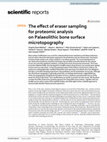
Scientific Reports, 2021
Bone surface modifications are crucial for understanding human subsistence and dietary behaviour,... more Bone surface modifications are crucial for understanding human subsistence and dietary behaviour, and can inform about the techniques employed in the production and use of bone tools. Permission to destructively sample such unique artefacts is not always granted. The recent development of non-destructive proteomic extraction techniques has provided some alternatives for the analysis of rare and culturally significant artefacts, including bone tools and personal ornaments. The Eraser Extraction Method (EEM), first developed for ZooMS analysis of parchment, has recently been applied to bone and ivory specimens. To test the potential impact of the EEM on ancient bone surfaces, we analyse six anthropogenically modified Palaeolithic bone specimens from Bacho Kiro Cave (Bulgaria) through a controlled sampling experiment using qualitative and 3D quantitative microscopy. Although the overall bone topography is generally preserved, our findings demonstrate a slight flattening of the microtop...

Journal of Paleolithic Archaeology
The exact strategies and technologies underlying Neanderthal hunting events remain open for debat... more The exact strategies and technologies underlying Neanderthal hunting events remain open for debate with lithic points being sparse across the European Middle Palaeolithic. An exception is the Neronian entity in southeast France, defined by ventrally retouched Soyons points. This study contextualises one of the largest Neronian assemblages, layer 1 at Abri du Maras. Our lithic analyses focussed on attributes described as indicative of projectile use or hafting to contextualise the morphometric and technological characteristics of the pointed implements at an assemblage level. We found that retouched points were made on a variety of blank types (including Levallois, laminar and discoidal flaking techniques) and ventral retouch is present across different artefact types (including points, scrapers and denticulates). Next, these lithic data were compared to similar typo-technological data recorded on a sample from the recently excavated and well-contextualised point-rich layer 4.1 of Ab...
Scientific Reports, 2021
Evidence of mobiliary art and body augmentation are associated with the cultural innovations intr... more Evidence of mobiliary art and body augmentation are associated with the cultural innovations introduced by Homo sapiens at the beginning of the Upper Paleolithic. Here, we report the discovery of the oldest known human-modified punctate ornament, a decorated ivory pendant from the Paleolithic layers at Stajnia Cave in Poland. We describe the features of this unique piece, as well as the stratigraphic context and the details of its chronometric dating. The Stajnia Cave plate is a personal 'jewellery' object that was created 41,500 calendar years ago (directly radiocarbon dated). It is the oldest known of its kind in Eurasia and it establishes a new starting date for a tradition directly connected to the spread of modern Homo sapiens in Europe.











Uploads
Papers by Virginie Sinet-Mathiot